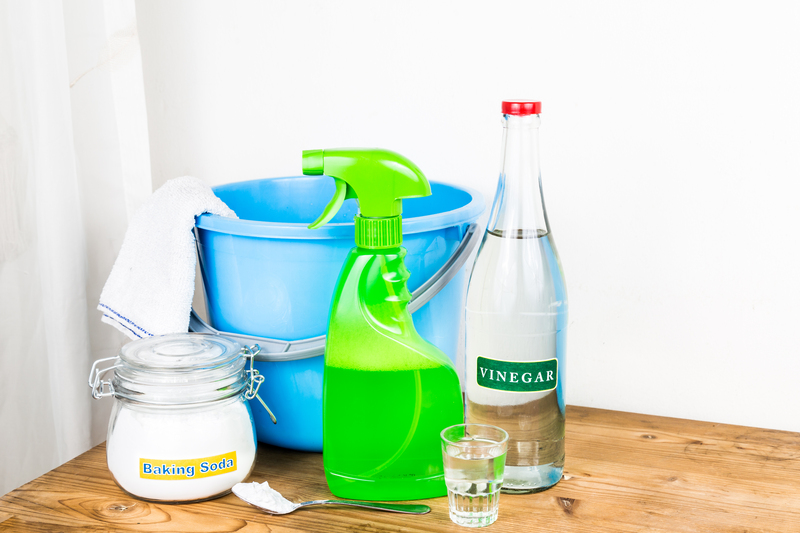Clean Sweep: Tenants' Guide to End of Tenancy House Cleaning
Posted on 02/10/2025
Clean Sweep: Tenants' Guide to End of Tenancy House Cleaning
Moving out of a rental property can feel overwhelming, and one of the biggest responsibilities tenants face is the end of tenancy cleaning. A thorough, professional-level clean is often the difference between getting your full deposit back or losing a portion to deductions. This comprehensive guide is designed to walk you through everything you need to know about end of lease cleaning, offering tips, checklists, and insider advice to ensure your move-out is smooth and stress-free.
What Is End of Tenancy Cleaning?
End of tenancy cleaning refers to the deep and thorough cleaning process conducted at the conclusion of a rental agreement. The goal is to return the property to its original, move-in condition, fulfilling all requirements stated in the tenancy agreement. This not only secures your deposit but also provides a clean slate for the next tenants.
- Deep cleaning every room, appliance, and fixture
- Removing limescale, stains, dust, and grime
- Making sure carpets, floors, and surfaces are sparkling
- Attention to hidden and hard-to-reach areas
End of lease cleaning is more detailed than regular weekly or monthly cleans. It is sometimes a contractual obligation, and landlords or letting agents will inspect the property before returning your deposit.

Why Is End of Tenancy Cleaning Important?
Aside from fulfilling your legal and contractual obligations as a tenant, carrying out a proper end of tenancy clean has several key benefits:
- Maximise Deposit Return: Most rental deposits are returned in full if the property is cleaned to a professional standard.
- Positive References: Leaving the property spotless can lead to good references from your landlord or agent, which can be valuable for future rentals.
- Smooth Handover: A clean property means fewer disputes and less stress during the moving process.
- Meet Expectations: Many tenancy agreements explicitly outline cleaning standards to be met. Missing these may result in deductions from your deposit.
End of tenancy house cleaning is essential if you want to avoid any unnecessary costs and ensure a positive end to your tenancy.
Should You Clean Yourself or Hire a Professional?
This is one of the most common questions renters have at the end of their lease. The answer depends on your budget, schedule, and cleaning prowess:
DIY End of Tenancy Cleaning
- Pros:
- Cheaper than hiring a professional company
- Full control over the cleaning process
- Satisfaction from doing a thorough job
- Cons:
- Extremely time-consuming
- Can be physically demanding
- If not done to a professional standard, you risk deposit deductions
Hiring Professional End of Tenancy Cleaners
- Pros:
- Expert cleaning, usually with a satisfaction guarantee
- Saves time and effort
- Cleaning companies often provide cleaning checklists approved by letting agents
- No risk of missing any hidden spots
- Cons:
- More expensive than DIY
- Need to book in advance, especially during peak moving times
Tip: If you're confident in your cleaning skills and have time to spare, a DIY end of tenancy clean can save you money. However, if you lack the time or want peace of mind, investing in a professional end of tenancy cleaning company is well worth it.
Essential End of Tenancy Cleaning Checklist
Whether you're hiring a professional or undertaking the clean yourself, a checklist is crucial to ensure nothing is overlooked. Here's your ultimate end of tenancy cleaning list, room by room:
General Areas (All Rooms)
- Dust and wipe skirting boards, light fixtures, and sockets
- Clean doors and handles
- Remove cobwebs from ceilings and corners
- Wash windows inside and out (where possible)
- Vacuum or mop all floors, including under furniture
- Wipe down any marks on walls (if permitted)
Kitchen
- Degrease and wipe all surfaces and countertops
- Clean inside and outside of cupboards and drawers
- Scrub sinks, taps, and remove limescale
- Deep clean oven, grill, hob, extractor fan, and microwave
- Clean fridge/freezer (defrost for at least 24 hours prior)
- Disinfect and wipe inside bins
- Clean and descale all appliances (kettle, toaster, etc.)
Bathrooms
- Scrub and disinfect toilets, baths, showers, and sinks
- Remove limescale from taps, tiles, and showerheads
- Polish mirrors and any glass surfaces
- Clean tiles and grout; address any signs of mould or mildew
- Empty and wash bins
- Replace toilet rolls or ensure holders are empty and clean
Bedrooms & Living Areas
- Vacuum carpets thoroughly; steam clean if required
- Wipe wardrobes, shelves, and drawers inside and out
- Clean underneath beds and large furniture
- Dust and polish surfaces, lampshades, and electronics
- Check for and repair any minor damages, such as picture hooks or loose handles
Outdoor Areas (if applicable)
- Tidy patios, balconies, gardens, or driveways
- Weed and mow lawns if you have been responsible for them
- Dispose of all rubbish and recycling
- Sweep entrances and walkways
Use this detailed move-out cleaning checklist as you go through each room to ensure nothing is left behind. Landlords and inventory clerks will typically inspect the property using similar lists.
Top Ten End of Tenancy Cleaning Tips
- Start Early: Begin your end of lease clean at least a week before your moving day.
- Declutter First: Remove all personal belongings to allow for easier and more thorough cleaning.
- Work from Top to Bottom: Always clean high surfaces first so dust falls down to be dealt with last.
- Use the Right Products: Invest in descalers, degreasers, glass cleaners, and disinfectants.
- Check Your Tenancy Agreement: Carefully read through your contract for specific cleaning requirements.
- Pay Extra Attention to Kitchens and Bathrooms: These areas usually undergo the most scrutiny during inspections.
- Don't Forget Carpets and Windows: These are commonly cited for deposit deductions if neglected.
- Take Photos: Document the property after cleaning as evidence in case of any disputes.
- Check Fixtures and Fittings: Make sure light bulbs, curtain rails, and other fixtures are dusted and working.
- Book a Professional Clean in Advance: If you're hiring help, slot it a day or two before your check-out inspection.
Common Areas Tenants Miss During End of Lease Cleaning
Even the most meticulous tenants can overlook certain areas during their move-out clean. These are the spots you can't afford to skip:
- Behind and beneath white goods (fridge, washing machine, cooker)
- Inside ovens and extractor fans
- Window sills and frames
- Air vents and radiators
- Inside wardrobes, cupboards, and drawers
- Skirting boards and picture rails
- Shower screens and bathroom extractor fans
- Light fittings, switches, and plug sockets
Paying attention to these details helps ensure your end of tenancy cleaning inspection goes smoothly and positively.
What To Expect During the End of Tenancy Inspection
Once you've completed your end of lease cleaning, your landlord or letting agent will conduct a final inspection using the initial inventory as a baseline. Here's what happens:
- Comparison with Check-In Inventory
- Detailed Room-by-Room Assessment
- Photographic Evidence Taken
- Noting Any Deductions or Areas of Concern
To avoid issues:
- Be present during the inspection if possible
- Have your inventory report to hand
- Retain cleaning receipts, especially if you have used a professional service
If the property is not up to standard, landlords may charge for additional cleaning services. That's why a meticulous approach to end of tenancy house cleaning is key.
Frequently Asked Questions (FAQs)
How long does end of tenancy cleaning take?
The time required depends on the size of the property and its current state. A basic studio flat might take 3-5 hours, while a three-bedroom house could require an entire day or more, especially if carpets and appliances need deep cleaning.
Do I need to clean carpets and upholstery?
Yes, most landlords expect professional-level carpet cleaning at the end of a tenancy, especially if the contract or inventory specifies this. Attend to any stains or heavy wear and tear, and consider hiring a steam cleaner if carpets are particularly dirty.
Is professional cleaning mandatory?
Not always, but some tenancy agreements specifically require a professional clean, and you may need to present a receipt. Double-check your contract to avoid disputes.
What cleaning products should I use?
Use non-abrasive cleaners for delicate surfaces, descalers for limescale, bleach for toilets, and a quality degreaser for kitchen appliances. Avoid products that could bleach or damage furnishings or fittings.
What happens if something is damaged?
If accidental damage has occurred (e.g., chipped tiles, stained carpet), inform your landlord honestly. Some minor repairs may be cheaper to fix yourself than the landlord's deductions.
Benefits of Hiring a Professional Cleaning Company
While DIY is possible, there are definite advantages to using a specialist end of lease cleaning company:
- Fully equipped and insured cleaners
- Attention to detail and professional standard
- Money-back or satisfaction guarantee
- Receipt for your landlord/agent
- Quicker, more efficient turnaround
- Peace of mind
For larger or heavily used properties, using a professional for your end of tenancy house cleaning can easily pay for itself in deposit retention and reduced stress during what is often a hectic moving period.

How Much Does End of Tenancy Cleaning Cost?
Professional end of lease cleaning varies by location, services provided, and the size of your property. As a rough guide:
- Studio flat: ?100-?150 ($120-$180)
- 1-bed apartment: ?140-?200 ($170-$250)
- 3-bed house: ?250-?400 ($320-$500)
Extra charges may apply for:
- Carpet cleaning or steam cleaning
- Upholstery or curtain cleaning
- Oven or appliance deep cleaning
- Outdoor area tidying
Always get a written quote and check reviews before booking a service, ensuring they offer a re-clean guarantee if the property fails its inspection.
Final Thoughts - Make Your Move-Out a Clean Sweep!
End of tenancy house cleaning is a crucial step in your move-out process that can have a major impact on your tenancy deposit and your reputation as a tenant. By following a structured cleaning checklist, paying close attention to detail, and ensuring all requirements are met, you set yourself up for a hassle-free handover. Whether you opt for professional cleaners or go DIY, remember--attention to detail pays off!
With these expert tips and the complete end of tenancy cleaning checklist, you can hand over your property with confidence, knowing your clean sweep stands up to any inspection. Happy moving!




